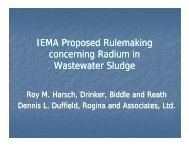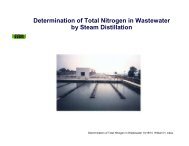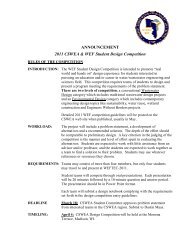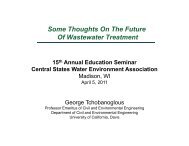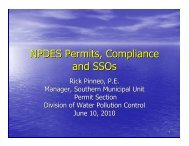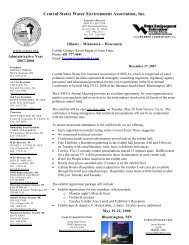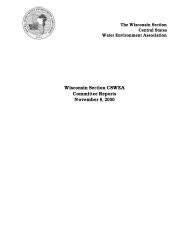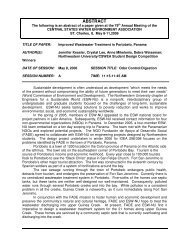Testing of Commercial Defoamant to Control Anaerobic Digester ...
Testing of Commercial Defoamant to Control Anaerobic Digester ...
Testing of Commercial Defoamant to Control Anaerobic Digester ...
- No tags were found...
You also want an ePaper? Increase the reach of your titles
YUMPU automatically turns print PDFs into web optimized ePapers that Google loves.
Filamen<strong>to</strong>us Microorganisms How do they end up in <strong>Anaerobic</strong> <strong>Digester</strong>s? Surface wasting and WAS from Aeration Basinsis sent <strong>to</strong> solids handling How do they produce foam in <strong>Anaerobic</strong><strong>Digester</strong>s? Filamen<strong>to</strong>us bacteria attach themselves on<strong>to</strong> thebiogas bubbles produced during anaerobicdigestion processes They prosper in anaerobic digesters due <strong>to</strong> theirability <strong>to</strong> metabolize hydrocarbons (abundant indigesters)
Operational ProblemsExcess froth in anaerobic digesters can result in operationalproblems: An inverse solids pr<strong>of</strong>ile insufficient stabilization Reduced digestion capacity andperformance Damage <strong>to</strong> digester equipment Health and safety issues Significant clean-up costs
Chemical <strong>Defoamant</strong>s<strong>Defoamant</strong>s alter the physio-chemical properties <strong>of</strong> foamby reducing the surface tension <strong>of</strong> the foam This action dissipates the foam on the gas bubbles that arestabilized by filamen<strong>to</strong>us microorganisms<strong>Commercial</strong> defoamants can be very effective atreducing foam in activated-sludge aeration tanks:Prior <strong>to</strong> <strong>Defoamant</strong> Addition During <strong>Defoamant</strong> Addition Day After <strong>Defoamant</strong> Addition
Application Guidelines (general)<strong>Digester</strong> Dosage is typically 5 ppm (based on <strong>Digester</strong> Volume) Higher initial dose <strong>to</strong> get concentration up in digester. Recommended continuous feeding during periods <strong>of</strong> problematicfoaming Feed Point: Recirculation loop (optimal), also Sump wells (post-clarification) <strong>Digester</strong> sampling ports Sludge feed Need <strong>to</strong> ensure adequate mixingAeration Tank Ideal if defoamant can be sprayedon <strong>to</strong> surface <strong>of</strong> foam (i.e. ESDs)
Surface Tension <strong>Testing</strong>The ability <strong>of</strong> a liquid <strong>to</strong> froth isrelated <strong>to</strong> its surface tensionSurface tension measurementstaken on FC Rel defoamant withDI water, MLSS, and digestedsludge using a CSC DuNouoyTensiometerCSC DuNouoy Precision Tensiometer
Surface Tension <strong>Testing</strong>FC Rel defoamant reduces frothing potential by reducing surface tension Lowering the surface tension helps dissipate gas bubbles which are stabilizedby filamen<strong>to</strong>us growthDigested Sludgehas lower surfacetension than ASdue <strong>to</strong> thepresence <strong>of</strong>biosurfactants,produced inanaerobicdigestionFC Rel <strong>Defoamant</strong>
Toxicity <strong>Testing</strong> Methanogenic bacteria, key <strong>to</strong> stabilizing digestersludge, are very sensitive <strong>to</strong> inhibi<strong>to</strong>ry substances Ensure defoamant used is non-<strong>to</strong>xic <strong>to</strong> themethanogen population Two <strong>to</strong>xicity tests performed <strong>Anaerobic</strong> Toxicity Assay Micro<strong>to</strong>x ® Toxicity Test
<strong>Anaerobic</strong> Toxicity Assay (ATA)ATA tests were performedin serum bottlescontaining digestedsludgeDosed with essentialnutrients, acetatepropionate(substrate),and varyingconcentrations <strong>of</strong>defoamantInhibition <strong>of</strong> methanogenicbacteria measuredthrough <strong>to</strong>tal gasproductionGas Volume Measured ByDisplacement or PressureTransducerMethane ContentMeasured via GCNutrient SolutionWith rbCOD added(ATA test only)<strong>Anaerobic</strong> SludgeSample (Inoculum)Butyl Rubber septa withaluminum crimp <strong>to</strong>p sealHead SpaceFroth <strong>Control</strong>AddititveTypical Serum Bottle Assay (250 ml working Volume)
ATA on FC Rel ® <strong>Defoamant</strong>FC Rel <strong>Defoamant</strong> Concentrations: 0-500 mg/LTotal GasProductionFC Rel defoamant was not found <strong>to</strong> be <strong>to</strong>xicGas Production RatesSerum bottle with highest dose performed best in terms <strong>of</strong> <strong>to</strong>tal gasproduced and gas production rate
Micro<strong>to</strong>x Toxicity TestThe Micro<strong>to</strong>x test measures the light-output <strong>of</strong>bioluminescent organisms, vibrio fischeri, when exposed<strong>to</strong> a potentially inhibi<strong>to</strong>ry substance <strong>to</strong> quantify <strong>to</strong>xicity Vibrio-fischeri produce light as a by-product <strong>of</strong> cellularrespirationThe Micro<strong>to</strong>x machine compares the light output <strong>of</strong> anon-<strong>to</strong>xic control <strong>to</strong> the light output <strong>of</strong> the bioluminescentbacteria exposed <strong>to</strong> a potentially <strong>to</strong>xic substance(defoamant)
Micro<strong>to</strong>x Test on FC Rel <strong>Defoamant</strong>EC 50 (effective concentration where there is a 50% loss <strong>of</strong> light output) <strong>of</strong> the Vibri<strong>of</strong>ischeri bacteria is above what typical dosing concentrations <strong>of</strong> theFC Rel defoamant would be
ATA and MicroTox ResultsFC Rel <strong>Defoamant</strong> showed no inhibi<strong>to</strong>ry or <strong>to</strong>xic impactat doses
Frothing Potential TestsA visual inspection <strong>of</strong> the effectiveness <strong>of</strong> FC Rel defoamantdetermined using a froth potential test Determined dosingFroth Potential <strong>Testing</strong>: Graduated cylinders with fine bubble diffusers connected <strong>to</strong> air flowregula<strong>to</strong>rs Froth samples (activated sludge or anaerobic digester sludge) Samples tested with various doses <strong>of</strong> defoamant Height <strong>of</strong> froth recorded initially, after 30-min <strong>of</strong> aeration, and after 1-min <strong>of</strong> settlingFoaming potential determined based on ratio <strong>of</strong> foam produced<strong>to</strong> the initial liquid height
Froth PotentialsStable and Unstable FrothStable froth is a better indica<strong>to</strong>r froth severity Unstable froth produced during aeration may dissipate once aerationhas halted‘non-frothing’ <strong>to</strong> ‘severe frothing’ based on qualitative analysis <strong>of</strong>test resultFroth Severity Rating SystemFroth Rating Stable Froth Unstable FrothNon-Frothing 0-0.1 0-1.0Mild Frothing 0.1-0.3 1.0-2.0Frothing 0.3-0.5 2.0-3.0Severe Frothing > 0.5 > 3.0
<strong>Defoamant</strong> <strong>Testing</strong>Test Setup<strong>Defoamant</strong> Test
Foaming Potential TestsFC Rel <strong>Defoamant</strong> on Froth from Activated Sludge &<strong>Digester</strong>s:<strong>Control</strong> 5 mg/L 15 mg/L 35 mg/L 50 mg/L <strong>Control</strong> 5 mg/L 15 mg/L 35 mg/L 50 mg/LActivated Sludge Sample during AerationDigested Sludge sample during aeration
Dosing TestsFC Rel <strong>Defoamant</strong> Dosing Determination on <strong>Anaerobic</strong><strong>Digester</strong> Sludge<strong>Testing</strong> showed FC Rel defoamant is most effective atreducing digester foam at a concentration <strong>of</strong> 5 - 10 mg/L
Full-Scale <strong>Testing</strong>Routine moni<strong>to</strong>ring <strong>of</strong> Froth Potentials provided insightin<strong>to</strong> upcoming digester frothing eventsNon-Frothing
Full-Scale <strong>Testing</strong> – Round 1 August 2011 – Routine sampling showedincreased foaming potential in digesters at theHunts Point WWTP
<strong>Testing</strong> Schedule – Round 1 August 2011 testing Initial defoamant dose added <strong>to</strong> <strong>Digester</strong> 2(Experimental <strong>Digester</strong>) <strong>Digester</strong> 3 used as a control Target dose <strong>of</strong> 15 mg/L Samples taken each morning and afternoon forfoaming potential testing <strong>Defoamant</strong> dosed on days 1, 4, and 8
<strong>Testing</strong> Setup
Results – Stable Froth
Results – Round 1Prior <strong>to</strong> defoamant addition, both <strong>Digester</strong>s exhibitedsevere froth ratios Very similar values for bothAfter defoamant addition, Dig 2 stable froth ratiosignificantly lower than Dig 3 Dig 2 stable froth ratio still in ‘frothing’ <strong>to</strong> ‘severe frothing’ range Addition <strong>of</strong> defoamant prevented further increase (observed in Dig3)Dig 2 consistently lower in both stable and unstablefrothing potential Use <strong>of</strong> defoamant in Dig 2 resulted in a reduction in frothingpotential.
Full-Scale <strong>Testing</strong> – Round 2 December 2011 – Routine sampling showedincreased foaming potential in digesters at theHunts Point WWTP
Full-Scale <strong>Testing</strong> – Round 2 Initial foaming potentialPreliminary Stable Froth Potential Results from 12-6-2011
<strong>Testing</strong> Schedule – Round 2 December 2011 testing Initial defoamant dose added <strong>to</strong> <strong>Digester</strong> 2(Experimental <strong>Digester</strong>) <strong>Digester</strong> 3 used as a control Target dose <strong>of</strong> 15 mg/L Samples taken each morning and afternoon forfoaming potential testing Holiday weekend necessitated a break in the testingmid-way through <strong>Defoamant</strong> dosed on days 1, 3, 5 and 6
HP Full-Scale <strong>Defoamant</strong> Addition
Results – Round 2 Second defoamant test did not show degree <strong>of</strong>impact seen in previous test Dose and timing were not as consistent due <strong>to</strong>holiday and back-order <strong>of</strong> defoamant Performed new defoamant dose test onfoaming sludge
<strong>Defoamant</strong> Dose Test
Results – Round 2 Results indicate that dose was not have beenhigh enough for sustained reduction <strong>of</strong> froth Initial dose <strong>of</strong> 15 mg/L was targeted Higher dose (> 20 mg/L) and more consistentdosing needed Recommendations Pre-test for dose optimization More frequent additions (daily)
Conclusions and Recommendations <strong>Defoamant</strong> is not <strong>to</strong>xic <strong>to</strong> anaerobic digestionprocess <strong>Defoamant</strong> is effective at reducing frothingpotential <strong>of</strong> digested sludge when applied at thecorrect dose Continuous addition <strong>of</strong> the defoamant, startingwhen frothing conditions are first noted, isrecommended <strong>to</strong> maximize the effectiveness <strong>of</strong>the defoamant addition A pre-test <strong>to</strong> confirm the dose required isrecommended prior <strong>to</strong> testing
AcknowledgementsVera Gouchev and David Wankmuller,Manhattan College GRAsSarah Dailey, Hazen and Sawyer EngineersAllen Deur and Keith Beckmann, NYCDEPResearch conducted through NYCDEP AppliedNitrogen Research Program (PO-88)This work is part <strong>of</strong> the WERF funded <strong>Digester</strong>Foaming Research Project which is cosponsoredby Hazen and Sawyer Engineers andBaxter and Woodman, with Dr. Krishna Pagillafrom IIT serving as Primary Investiga<strong>to</strong>r.



